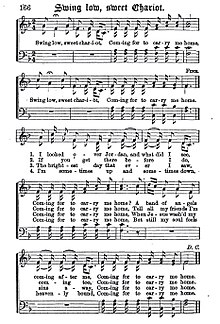Pushmataha County, Oklahoma
| Pushmataha County, Oklahoma | |
|---|---|

The Pushmataha County Courthouse in Antlers.
|
|
 Location in the U.S. state of Oklahoma |
|
 Oklahoma's location in the U.S. |
|
| Founded | 1907 |
| Seat | Antlers |
| Largest city | Antlers |
| Area | |
| • Total | 1,423 sq mi (3,686 km2) |
| • Land | 1,396 sq mi (3,616 km2) |
| • Water | 27 sq mi (70 km2), 1.9% |
| Population (est.) | |
| • (2013) | 11,233 |
| • Density | 8.3/sq mi (3/km²) |
| Congressional district | 2nd |
| "Swing Low, Sweet Chariot" | |
|---|---|

Page from The Jubilee Singers, 1873
|
|
| Song by Fisk Jubilee Singers (earliest attested) | |
| Written | Prior to 1862 |
| Genre | Negro spiritual |
| Writer(s) | Wallace Willis |
Pushmataha County is a county located in the southeastern part of the U.S. state of Oklahoma. As of the 2010 census, the population was 11,572. Its county seat is Antlers.
The county was created at statehood from part of the former territory of the Choctaw Nation, which had its capital at the town of Tuskahoma. Planned by the Five Civilized Tribes as part of a state of Sequoyah, the new Oklahoma state also named the county for Pushmataha, an important Choctaw chief in the American Southeast. He had tried to ensure that his people would not have to ceded their lands, but died in Washington, DC during a diplomatic trip in 1824. The Choctaw suffered Indian Removal to Indian Territory.
During prehistoric times, Pushmataha County was part of the territory during the Middle Woodland period of the Fourche Maline culture. Over time, and possibly through contact with the Middle Mississippian culture to their northeast, the Fourche Maline became the Caddoan Mississippian culture. Their center was at Spiro Mounds, near Spiro, Oklahoma. The elite organized the construction of complex earthwork mounds for burial and ritual ceremonial purposes, arranged around a large plaza that had been carefully graded. This center of political and religious leadership had a trade territory encompassing the full extent of the Kiamichi River and Little River valleys. This 80-acre site is preserved as Oklahoma's only Archeological State Park. The larger Mississippian culture traded from the Great Lakes to the Gulf Coast.
...
Wikipedia
